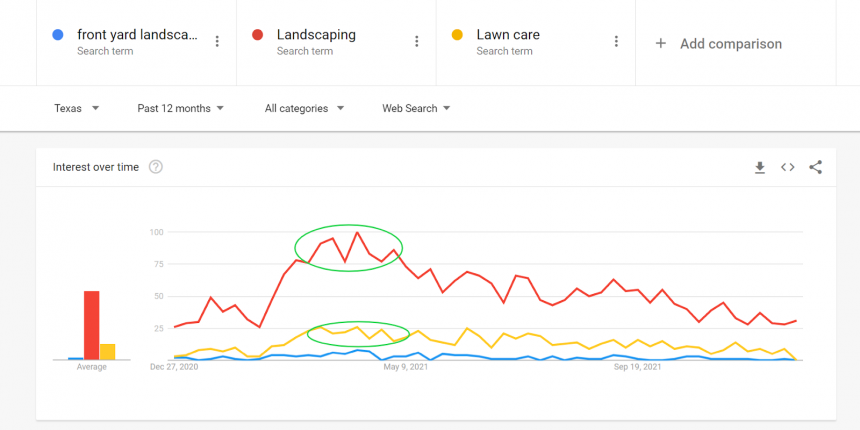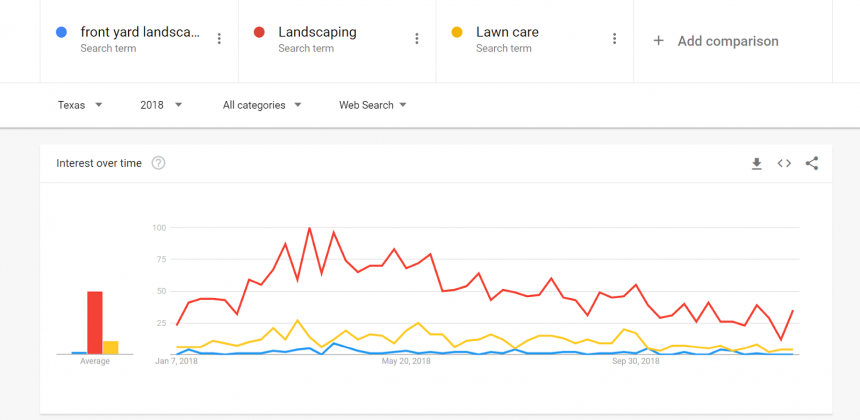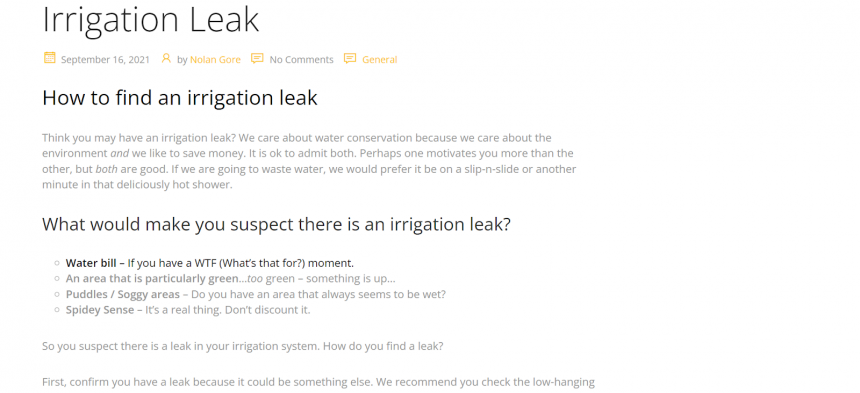In 2021, 51% of local businesses paid for content creation and optimization, which is up from 28% in 2020.
Even with an improved design, ranking in the Local Pack is no longer enough—more local businesses want to appear in the organic search results. This is because local search is emerging as a powerful marketing channel for driving traffic and improving customer acquisition.
With this in mind, the next logical step for your clients would be choosing relevant blog topic ideas, then publishing content around these topics, right?
It sounds good on paper, but in reality, without data to decide what topics to choose, you’re flying blind. At the core of choosing what topics to publish is this formula:
What people are searching for online + the level of interest = the topics you choose to write about
So publishing ‘better content’ than what your clients’ competitors are publishing, without understanding the logic behind their approach, won’t give you a huge tactical advantage.
So if you’re looking to have a constant stream of blog topic ideas that move the needle for your clients’ businesses, here are five of my favorite data-driven ways to do so.
1. Use Google Trends To Find Trending Local Topics
Data from Google Trends shows you the level of interest for a particular topic—that people are searching Google for—on on a scale of 1-100.
For the best results, use Google Trends to compare interest levels for different topics over a particular time range.
If your client’s business has branches in different regions, compare the level of interest for the topic in each of these locations to help you decide which topics to focus on.
To show you how to derive insights from the data you collect on a specific topic, I’ll plug in three topics; front-yard landscaping, landscaping, and lawn care, into Google Trends for a landscaping design and maintenance business:

Notice the spikes in interest for landscaping in March and April. With this information, you can do two things:
- Use the content improver template from Jarvis to update your library of old content for freshness and relevance.
- Focus on landscaping as your content theme in the first quarter of the year to help you build an audience.
If you’re not sure about the second point above, let’s filter our data to see trends and interest levels over time, and also compare how different regions search for each topic.
Here’s a snapshot showing you interest levels from 2018 – 2021:

Further down the search results, you’re going to find a breakdown for different metropolitan areas—this can help you decide which topics are relevant in specific locations:

You’ll also find long-tail keywords that prospects use in their searches. These help to reveal the search intent and context when a user is looking for information about landscaping:

Bringing it all together, there’s more interest around ‘landscaping’ compared to ‘lawn care’ and ‘front yard landscaping’.
Most searchers in metropolitan areas are looking for content about landscaping rocks and garden design landscaping.
The common search terms used also show that these users are familiar with landscaping, so they could be in the consideration or decision stage of their buying journey. In this case, our blog topics will be based on terms such as ‘river rock landscaping’, ‘garden design landscaping’, and places where they can find landscaping rocks in their location.
Related: Free Video Course – How to Create Website Content for Local SEO
2. Mine Customer Feedback For Pain Points
When starting out with content creation for your clients, you’re more likely to get results faster by paying attention to a specific topic until you’re ready to scale.
This is important if your client wants to establish themselves as a thought leader by ranking for a set of specific high-value local search terms. This tactic allows them to drive traffic and to build an email list from scratch.
However, when you’re scaling, listen to customer feedback in the form of reviews, sales call recordings, and customer support emails to identify additional blog topics.
A customer complaint in reviews or support emails means that there’s an unmet expectation. Your client’s customer could be unhappy with the service or doesn’t understand how the service works.
Address negative reviews and complaints by choosing blog topics related to how the client’s services work and answer frequently asked questions from customers.
A sales call recording will reveal the objections they have and alternatives they consider. Turn the sales call transcript into a comprehensive list of alternatives for your client’s audience, talking about different service providers, their pricing, and pros and cons.
Take this review, from Top Choice Lawn Care as an example:

While customers share how Top Choice Lawn Care solved their problems, they also highlight underlying issues in their irrigation system.
If you look at one of Top Choice Lawn Care’s recent blog posts, here’s what you will find:

Positive reviews may also reveal a customer’s primary motivations and different use cases of a service.
Turn these into case studies and optimize them for relevant long-tail keywords to help this content rank and show up in search results.
The idea here is to identify patterns in the issues that customers raise in their emails and calls to the customer service department.
3. Run Surveys Asking Your Audience about Their Favorite Topics
An equally important part of your client’s audience is the prospects who make up a sizeable chunk of their email list.
Running a survey with relevant questions reveals their needs, challenges, and pain points while multiplying the number of blog topic ideas you get. A section of subscribers who respond to your survey will provide a list of general blog topics that they want you to talk about, while another section will provide specific types of topics you need to talk about.
Cumulatively, you have content to create for a general audience and content for different segments. These additional segments will suggest specific topics according to their needs, challenges, and pain points.
The challenge with surveys, however, is survey fatigue. More than half of your respondents won’t spend more than three minutes responding to your questions.
In addition to reducing the number of questions in your survey and asking fewer open-ended questions, timing is important. Rather than sending surveys every quarter, include a survey at the tail end of your welcome email series when your client’s brand is still fresh in the subscriber’s mind.
Given that a new subscriber signed up for because they’re interested in your client’s brand, what would prevent them from telling you the kind of content they want to read?
4. Fill in Content Gaps in the Buyer’s Journey
A content gap analysis allows you to create content around topics that your clients’ prospects want during their buying journey.
While your search audits reveal content gaps, you also need to look at the critical touchpoints in the buying journey of your client’s prospects. You can then align your blog topics by answering the questions they have.
For example, if your client provides pest control services, you may have content that only targets web visitors who are looking for help eliminating bugs and rodents in their homes.
If a prospect isn’t yet looking to pay for a service, here are a couple of questions they may have on their buying journey that reveal potential content gaps:
- How can I stop creating breeding environments for pests?
- Are there pests that thrive during specific seasons of the year?
- How does your service compare with others in my area?
Here’s an example from Orkin, a pest control service provider showing their competitors:

When I plug these competitors into the keyword gap tool and compare it with Orkin’s competitors, it reveals the shared keywords and missing opportunities that I can focus on. These keywords are related to the questions we asked earlier:

So a content gap analysis is more than just plugging a competitor’s keyword into SEMrush—or any other SEO software you’re using—and creating content on the keywords your competitors are ranking for.
The topics you write about need to be relevant to a prospect’s buying journey by meeting their search intent.
5. Collect Feedback on the Content You’re Already Publishing
Analytics data will tell you about how your client’s audience behaves, but won’t explain the reasons behind their behavior.
If your client’s web pages have a high bounce rate, would you attribute that to content relevance, low quality content, and a bad user experience on their website?
You won’t be able to connect the dots until you ask web visitors for feedback about the content you’ve published. With this feedback, you’ll be better informed regarding the content ideas you need to focus on, and in some cases, the topics you need to simplify for your audience to understand.
Here’s a good example of a website poll that pops up after a user finishes reading a blog post:

You should also consider tying your questions to different use cases of your client’s products or services to help you collect content creation ideas. Here’s how GatherContent does it:

The responses will tell you if the topics you cover are too advanced for your audience, and whether you need to localize your content to help you meet the needs of different segments.
The responses will also help inform what you include in your content calendar and even give you an idea about the level of awareness a web visitor has about your client’s business.
Ready to Get Started?
Using data to choose blog topics is one of the most impactful things you can do for your client’s local business. However, it pays to be aware that relying on content to drive traffic and improve customer acquisition for local businesses is a long game.
The ways we just discussed above will sustain you by providing you with a constant stream of valuable topics, even when you feel like your creative well is running dry.

